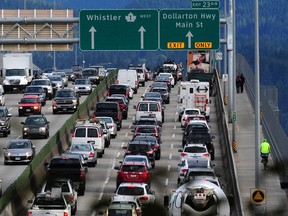Douglas Todd: As population grows, rants and raves about traffic bottlenecks are now as common across Metro Vancouver as complaints about overwhelming house prices.

About 15 years ago some of my soon-to-be-retired friends said they were moving away from Metro Vancouver largely because of increasing traffic congestion.
I was dubious. It seemed a weak reason.
But now their decision to set up a home in Vernon is understandable. Along with housing prices and the Vancouver Canucks, traffic jams are more and more a fiery topic in Metro Vancouver.
Most of us know Metro residents who are considering voting with their feet in part because of traffic bottlenecks.
Whether it’s griping about the stop-and-start trip from Vancouver to Chilliwack, grinding to a halt on the Iron Workers Memorial Bridge or limping along once-smooth-flowing 16th Avenue to UBC, rants and raves about gridlock are too many to count these days.
North Vancouver city Mayor Linda Buchanan recently aired the emotions of many across the region when she said, “Anyone living on the North Shore knows traffic congestion has reached a tipping point. People are spending too much time commuting and not enough time living.”
A regional council of mayors has acknowledged, “Anyone who tries to get around the region knows Metro Vancouver is suffering from congestion.” It frustrates commuters every single day, the mayors said.
“It’s what you would expect from population growth,” said Dan Mountain, spokesperson for TransLink.
But it’s almost impossible to get the government bodies responsible for transportation to provide comparative trip times from either the era of Expo 86 — for which the motto, perhaps ironically, was “world in motion, world in touch” — or more recently.
Mountain admitted it’s difficult to provide historic data on commuting times. I ran into similar polite bewilderment, or in some cases avoidance, from spokespeople for the Metro Vancouver regional district, the Ministry of Transportation and the city of Vancouver, all of which in different ways are responsible for responding to increasingly tortuous traffic volume.
Given the information bottleneck from governments, the only really useful tidbit of data came from TransLink, which said that transit trip times across Metro Vancouver are now on average 8.5 per cent slower than in 2013.
The city of Vancouver did not get back by press time, despite having three working days to do so.
And all the Ministry of Transportation offered was a sample of bridge volume data that proved meaningless. The ministry official said it had no information on volumes on the Iron Workers Memorial Bridge to North Vancouver, which is currently among the most problematic.
For his part, John Shepherd, a business professor at Kwantlen Polytechnic University who lives in Richmond and commutes to teach in Surrey and at UBC, said, “Gridlock is getting worse, including this fall.”
Some of Shepherd’s family members in Richmond are considering quitting their jobs because of the increasingly “brutal” trip to downtown Vancouver.
Despite the reluctance of B.C.’s different levels of government to provide real information on worsening travel times, they are trying to respond to the exasperation.
They’ve been adding SkyTrain extensions in Surrey, building a new bridge in New Westminster, adding HOV lanes, widening highways, prioritizing buses and constantly adjusting transit routes.
To the chagrin of some drivers, however, local governments are also doing things that can slow trip times. In the debate over which mode of travel should get preference, they are instituting traffic-calming measures, replacing vehicle lanes with bicycle paths and installing more pedestrian-activated lights.

An official of the Ministry of Transportation confessed, in a conversation not meant for attribution, that staff wished they knew what the solution was to deteriorating commuting times.
The official remembered being in his parents’ car as a young person, cruising the Trans-Canada Highway from Chilliwack to Vancouver, and being able to count virtually every passing car. There were that few.
Now, coming into Vancouver from the Fraser Valley, the official noted the bumper-to-bumper highway traffic often begins around Chilliwack, which is almost 100 kilometres from downtown.
After facing years of outcry, the B.C. government finally has bulldozers expanding the Trans-Canada from Langley to Abbotsford.
Whatever the proposals, solutions won’t come easily for Metro Vancouver’s over-stressed, labyrinthine commuter complex. The well-being of residents, however, hangs in the balance.